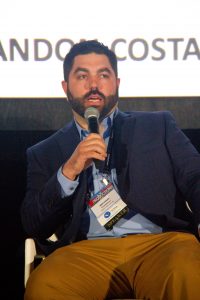IP Production Forum: At-Home Productions of Domestic, International Competitions Test Long-Distance Workflows
The NWSL, U.S. Open Cup, Copa America, and the 2019 FIFA Women’s World Cup were all discussed
Story Highlights
The “beautiful game” cannot be confined by a set of boundaries. With the love for soccer reaching both local and global audiences, tournaments occurring within our borders and abroad have called for new ways to produce matches in a more efficient, but smart manner. As rightsholders and leagues continue to embrace IP-based workflows, they push the needle to find the correct balance between driving production costs down while also refraining from negatively impacting the quality of their coverage.
At last week’s IP Production Forum, executives who take part in these offsite productions discussed the popularity of IP in the arena of soccer, how each individual is leveraging the practice to put on respective shows throughout 2019, and the current state of at-home productions.
Bizzy Signals Entertainment President Michael Cohen on why IP works for low-scale productions
“Soccer has always been at the forefront of at-home productions. The international stature of the sport makes it a reliable solution. What we’re now seeing here [in the United States], there is just so much soccer going on domestically with the United Soccer League and National Women’s Soccer League. [Those two leagues] don’t usually have the budgets where you can go out and put together a $200,000 production. The REMI model lends itself to those competitions.”
VISTA Worldlink Executive Producer Mike Freedman on the company’s efforts on the 2019 Lamar Hunt U.S. Open Cup
“For the first couple of rounds, it is fully amateur, so you might be playing in parks and fields that are right down the street. We had to figure out the camera setup with platforms or lifts, if we needed to bring satellite trucks or IP transmission. The beginning stages had 55 games during the first three rounds over a period of six days. Our strategy entailed planning with the onsite crews on how we’re getting the signals back, and then once we got them back, it was about pushing them to the appropriate producers, directors, replay and graphics operators.”
Cohen identifies how at-home productions within VISTA Worldlink are perfect for NWSL matches
“When I was contacted by the NWSL in 2015, they were looking for efficient ways to get games on the air because they were playing in smaller stadiums and weren’t doing any broadcasts. Now, this is the first time in the history of women’s soccer that there were network deals in place to capture the aftermath of what happens at a FIFA Women’s World Cup. You’re starting to see the attendance rise and more television attention because the games produced with REMI are four-fifths of the games each week that are being distributed all over the world.”
Telemundo Deportes VP of Production Roberto Pardo explains the role of IP during the Summer of Soccer initiative
“We basically had 10 months of planning and quickly access how we were going to double our efforts [for the 2019 FIFA Women’s World Cup and Copa America]. For example, we needed two host positions, to divide our expertise of our producers, and kick the tires on this [IP production facility]when we were thinking that we needed to replicate what we were doing for the FIFA World Cup [in Russia]. REMI allowed us to do all of those things as well as send prompter tallies and test FIFA’s multi-feed for the first time. IP gave us the vast flexibility to present these two major tournaments to the fans in a way [that met] our expectations.
“Before, very few events merited going out to Central America or the Caribbean for some of these World Cup qualifiers, so shipping a production truck there didn’t make much sense. IP was very normal for the Telemundo team in attendance, but for all of the other people who did their own style of production, it was a shock. For us culturally, [at-home with IP]I wasn’t’ that much of a shift. We were able to enhance our digital exclusive matches from the FIFA Women’s World Cup, but before by adding some additional vantage points. IP allows us to think a little different since that comfort level is there.
Cohen believes that at-home productions can push behind-the-scenes operators to develop a solid skillset
“When you start looking at the massive amount of shows that are underneath [high-end shows like Sunday Night Football and Monday Night Football], there is an incredible opportunity. With quality switchers, voiceover capabilities, and replay abilities, we are able to [confidently] air some of these broadcasts on network television because of the quality. The other thing that is intangible and that others don’t really think about is that we’re starting to develop all of this talent not only in front of the cameras, but behind the cameras. That’s a benefit to every network because these kids are getting close to 100 games per season. A lot of these individuals behind the scenes are getting a tremendous amount of experience because we’ve become a recruiting station for other traditional networks and REMI productions.”
Freedman dissects why REMIs are becoming more mainstream as time goes on
“Four or five years ago, in terms of soccer or any sport, you would say ‘Wait, they’re doing that game remotely and not doing a full, traditional production?’ Fast forward to where we are now, the script has been flipped to where people say ‘Oh, why are they sending a full crew to that venue?’ In that regard, people are much more accepting of REMI, but overall, people just want the content and see the game. If you can do that at a high-level, it doesn’t matter if it’s REMI or traditional.”
Freeman on how IP can further amend at-home productions to improve broadcast quality
“As anybody knows, traditionally when you go out and produce a game in a truck, you’re never going to have a perfect show because something could go wrong. The good thing about that is, after that show, you’ll talk about so when you’re back at a game together next week, the mistake is corrected and you move on. In this scenario [while at-home], you’re not necessarily doing that. A camera person might make a mistake, they’re not talking about it with the director and then next week, it might be the same crew and then here we go again. Communication [between the onsite and offsite teams] is even more important. For us, we’re a younger staff, so there’s never enough phone calls and communication. Sometimes emails and texts are good, but we have weekly calls with our production members onsite to make sure that that message always gets across.”
Pardo details Telemundo’s process of effective communication despite two teams on two different continents
“We basically had two teams leading each major tournament. Since we were here together, we were able to compare notes and actually apply things that one producer did in one match that worked out. There is definitely some of that ‘on the ground’ energy that could play as a factor, but you can make certain choices that are made on the ground with constant communication [at-home] as well.



